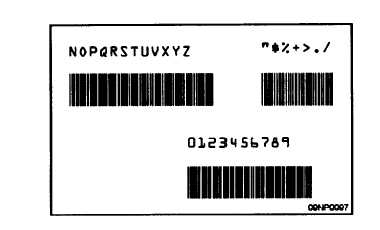| |
Figure 11-3.—Example of a 3-of-9 bar code arrangements.
spaces when a given number of bars are read and vice
versa. If the scanner reads an incorrect number of bars
for the number of spaces read (or vice versa) or if the
read data element is not begun and ended with a
start/stop mark, then a “no-read” condition exists. With
a good quality marking, the first read rate is near 100%
and the character substitution (misread) rate is less than
1 error per 6,000,000 characters read. However, less
than desired printing quality or label condition will
degrade the first read rate, while the character
substitution rate will be affected only slightly.
Our computers today depend on us to manually
input data into a device that converts information into a
machine acceptable form-punched cads, magnetic
tapes, or electric signals from a terminal. As we have
all experienced, manual input is prone to error and speed
is limited to a person’s manual dexterity. Bar code data
can be scanned and converted accurately into computer
usable form without manual keying.
BAR CODE APPLICATIONS
From the moment material first enters the supply
system until it is issued, these bar codes can be scanned
to provide key data for a variety of applications such as
Location Survey —Presently, the Uniform
Automatic Data Processing System-Stock Point system
(UADPS-SP) produces a tape with the location to be
surveyed and each stock number that is supposed to be
in that location. his tape is converted to cards. The
warehouseman uses these cads to go to the location,
check material in the bin, and handwrite corrections on
the cards. The cads are returned for keypunching. The
punched cards are then converted to tape which is used
to update the Master Stock Item Record (MSIR).
With the locations labeled with their number in bar
code and a portable scanner, cards are eliminated The
scanner would be loaded with images from the
UADPS-SP tape. The warehouseman is prompted by
the scanner to go to a particular location. The
warehouseman confirms he is at the right place by
scanning the location bar code label. The scanner then
displays what stock number should be in the bin, its
condition code, shelf-life, etc. The warehouseman
validates this information, makes corrections on the
scanner’s keyboard, and inputs any stock number in the
location which is not shown on the scanner.
These
scanners have up to 60,000 character memories so the
warehouseman can survey a number of locations.
When the warehouseman is done, the scanner’s
information is converted into a tape which updates the
MSIR.
Physical Inventory—To conduct a physical
inventory, portable scanners are used in a way similar
to a location survey. The locations and items to be
inventoried are loaded into the scanner, the items
inventoried, and the scanner’s data passed to the main
computer. As more and more incoming material is bar
coded, the warehouseman will be able to scan the bar
code label with the stock number on the item’s box
rather than write it down or key it into a scanner.
Material Receiving—Scanning light pens attached
to a video terminal will be used to obtain the stock
number and contract number off the incoming outer
container. With these two pieces of data, the computer
system will retrieve other pertinent information about a
receipt from the Due-In File. The receiving personnel
can input quantity received and be told where this item
should be stored. The capability to print a barcode label
for those items received without labels will also
available.
AUTOMATIC DATA PROCESSING
One of the most significant characteristics
be
o f
automatic data processing (ADP) is that a complete
series of operations can be planned The machine can
then be directed to carry them out without further
human intervention.
An ADP installation which includes several
individual equipments is usually called a SYSTEM.
The system must be able to accomplish four
fundamental functions.
Accept data
Accept instructions
11-3
|

